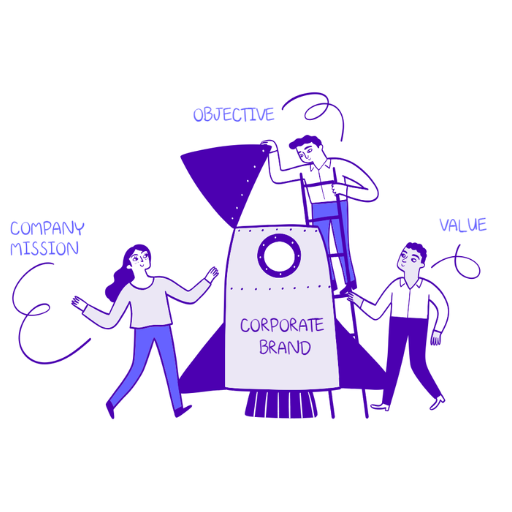
Designing meaningful, memorable, transformative experiences for people is easier when you understand the principles that drive them. In their book, "Designing Experiences," J. Robert Rossman and Mathew D. Duerden share experience design principles that can be game-changers for leaders and their brands.
Many companies today are realizing the importance of creating great experiences for their customers and employees. It's not just about the products and services anymore—what really sets businesses apart is the quality of the experiences they provide. But figuring out how to design these experiences can be a challenge. That's where customer-centric design comes in.
This blog post explores the essence of customer-centric design and how it's the key to creating meaningful interactions that lead to long-term success. From understanding what makes people engage to mastering the art of storytelling, we'll take a deep dive into the principles and practices that drive exceptional experience design.
Understanding the Significance of Experiences in Business
Understanding how experience design works reveals how people and their environment interact to shape outcomes. Companies like USAA and Costco use tools like the Net Promoter Score (NPS) to see how loyal customers are, showing how important good experiences are today. Investing in experiences not only makes people happier in the long run but also protects against bad experiences, especially online. Businesses now see how making employees happy also makes customers happy, so they focus on creating great experiences for both. By learning from experiences and always trying to make them better, companies ensure people keep coming back for more, whether they're customers or employees.
Crafting Immersive Experiences: Balancing Excitement and Calmness
Through exploring the concepts of play and flow, it becomes evident that finding the right balance between excitement and calmness is key to crafting immersive encounters. By understanding individuals' unique preferences and needs, experience designers can tailor experiences that resonate deeply, avoiding overwhelming participants in the process. Embracing principles from the PERMA model, experience designers strive to foster positive emotions, meaningful relationships, and a sense of accomplishment, ultimately guiding participants on a journey of self-discovery and enrichment.

Five Levels of Experience
Each type of experience offers unique opportunities for engagement and enrichment, from the routine aspects of daily life to the profound transformations that shape our identities and perspectives. By understanding the nuances of each type and leveraging appropriate design strategies, designers can create compelling and meaningful encounters that leave a lasting impact on users' lives.
In brief, here are the five levels of experience and the keys to facilitating them:
- Prosaic: Routine things you do every day. We ignore the technical aspects of an experience unless they’re done poorly or not at all. You must get them right, or participants will remember them negatively. Examples include clean bathrooms, knowledgeable staff, good communication and safety. These are table stakes inputs.
- Mindful: Engage participants mentally by moving them from System 1, autopilot thinking, to System 2, deliberate thinking, by creating an unexpected and welcome intervention that gets attention. For example, airlines use humor to get passengers' attention in reviewing safety instructions before take-off.
- Memorable: Engage people emotionally for memorable experiences. Positive feelings make mindful experiences memorable and shareable, while negative emotions can also leave a lasting impact. You should plan to address potential issues swiftly for a seamless experience.
- Meaningful: This type of experience emerges when someone learns something significant, often through co-creation with the designer. Allow for downtime after intense touchpoints for reflection, ideally with others, to transform memorable moments into meaningful ones.
- Transformational: These rare experiences can profoundly change individuals, like discovering a health condition and committing to a healthier lifestyle. Transformational experiences leverage mindfulness, memorability, and meaning to evoke change. Designing for change is challenging, as reactions vary among participants. Understanding individual motivations is crucial for effective design.
Understanding the Experiencescape
Just as a landscape architect plans a landscape, experience designers shape the experiencescape, comprising six key elements: people, place, objects, rules, relationships, and blocking. People's roles are pivotal, requiring an understanding of their motivations and diversity. Place influences encounters, with sensory aspects enhancing immersion. Objects and rules within the experiencescape guide interactions and set boundaries. Relationships among participants enrich experiences, while effective blocking guides their journey. Embracing technology is crucial, with online platforms offering opportunities for authentic engagement.
Design Thinking: A Guide to Innovative Experience Design
Design thinking revolutionizes experience design by embracing imperfections and failures as inherent components of the process. Like navigators of "wicked problems," designers navigate the complexities of the experiencescape, prioritizing empathy and human-centered approaches. The five-stage framework—Empathize, Define, Ideate, Prototype, and Test—offers a structured path for iterative design, fostering rapid learning and progress.
Empathize: Designers dive into participants' worlds, gathering insights through observation, engagement, and interviews to understand their needs and perspectives deeply.
Define: Insights are distilled into a clear problem statement, known as a Point of View (POV), guiding the design process with a focused direction.
Ideate: Creativity flows as designers generate a multitude of solutions, encouraging divergent thinking and collaboration to identify promising ideas.
Prototype: Selected ideas are transformed into tangible artifacts, allowing designers to gather feedback and refine the experience before full implementation.
Test: Prototypes undergo rigorous testing to validate assumptions and refine designs based on user feedback, ensuring the final experience meets users' needs and expectations.
By embracing design thinking principles, designers craft compelling and meaningful experiences that resonate authentically with their audience, driving innovation and excellence in experience design.
A Symphony of Intentionality and Heterogeneity
Designing experiences is like composing music, where intentionality and heterogeneity are key. Intentionality means paying attention to every detail, ensuring a seamless blend of micro-experiences. From Buc-ee's cleanliness focus to Disney's immersive storytelling, intentional design elevates experiences. Heterogeneity celebrates diversity, infusing unique elements to keep participants engaged. By strategically arranging varied micro-experiences, designers create captivating journeys. Essential elements like personas, touchpoints, reactions, and contributors empower designers to understand and enhance user experiences comprehensively.

Leveraging Touchpoints and Transitions
In experience design, every interaction matters. It's like putting together a puzzle or painting a picture. Designers plan each step carefully to create meaningful experiences. The Touchpoint Template helps with this. It's like a guide that helps designers organize and improve each interaction. From deciding what happens next to how people feel, every detail is important. Co-creation is also key. It lets participants have a say in what happens, making the experience more authentic. Transitions are often forgotten, but they're essential. They help move people smoothly from one part of the experience to the next. By following these ideas and using the Touchpoint Template, designers create experiences that people won't forget.
Crafting Immersive Experiences: The Power of Storytelling
Experiences are more than just transactions; they're stories waiting to be told. Stories have a remarkable ability to resonate with people, providing meaning and depth to their experiences. Companies that understand this leverage storytelling to create immersive narratives that captivate their audience. Just like Disney's enchanting theme parks or Universal Studios' magical Wizarding World of Harry Potter, successful experiences are built on compelling stories. They follow structures like Gustav Freytag's dramatic arc or Joseph Campbell's hero's journey, ensuring that participants are engaged from beginning to end.
But it's not just about the front story; it's also about the untold backstory that enriches the experience. By embracing storytelling in experience design, designers become the architects of unforgettable narratives, shaping experiences that leave a lasting impact on participants.
Enhancing Experiences: Techniques for Memorable Encounters
Crafting remarkable experiences is akin to baking a cake – each step is vital. Before adding decorations, the cake must be moist and delicious; similarly, experiences must be well-designed before enhancements are applied. Technical factors form the foundation of experience design, ensuring quality and consistency. Effective communication, competence, courtesy, credibility, and recovery are essential technical elements outlined by Parasuraman and colleagues. These factors serve as a checklist for delivering high-quality experiences.
While technical aspects provide the backbone, artistic factors elevate experiences to new heights. Characterizing experiences with distinctive elements, customizing interactions, and empathetic communication are strategies to deepen engagement. Memorializing experiences through sensory surprises, personalized themes, and thematic harmony creates lasting memories. These techniques, when thoughtfully applied, transform ordinary encounters into extraordinary ones, leaving participants with indelible impressions.
Conclusion:
"Designing Experiences" by J. Robert Rossman and Mathew D. Duerden offers invaluable insights into customer-centric design, guiding businesses to create transformative encounters. By understanding each type of experience, organizations unlock opportunities for growth and differentiation. From effective communication to sensory surprises, the book outlines techniques for enhancing experiences, elevating offerings from ordinary to extraordinary. Through empathy, creativity, and innovation, companies embark on a journey of excellence, where every interaction becomes an opportunity for connection, growth, and meaningful engagement.
Frequently Asked Questions
Experience in experience design refers to how users or customers feel and interact with a product, service, or brand. It's about creating enjoyable and meaningful experiences at every step of the customer journey. Experience design ensures every touchpoint is user-friendly and engaging, aiming to exceed expectations and build loyalty.
Experience design (XD) is broader than user experience (UX) design but closely related. UX design focuses on making digital products easy to use, while experience design considers all interactions, whether online or offline. Experience design aims for consistency and coherence across different touchpoints, ensuring a seamless and delightful experience.
Design experience is all about how users perceive and interact with a product or service. It includes how easy it is to use (user experience) and how it makes users feel (customer experience). A good design experience considers factors like usability, aesthetics, and emotional connection to create enjoyable and satisfying interactions.
A great experience design effectively meets users' needs and leaves a positive impression. It's intuitive, visually appealing, and consistent across all touchpoints. It also considers users' emotions and builds meaningful connections with the brand. Ultimately, it leads to high customer satisfaction and loyalty in today's experience-driven economy.


.png)


%20-%20Made%20with%20PosterMyWall.jpg)
.png)
.png)
.png)

.png)

.png)




.png)








.png)
.png)
.png)

.png)



.png)




.png)







.png)
.png)

.png)
.png)


.png)
.png)


.png)
.png)

.png)
.png)
.png)
.png)